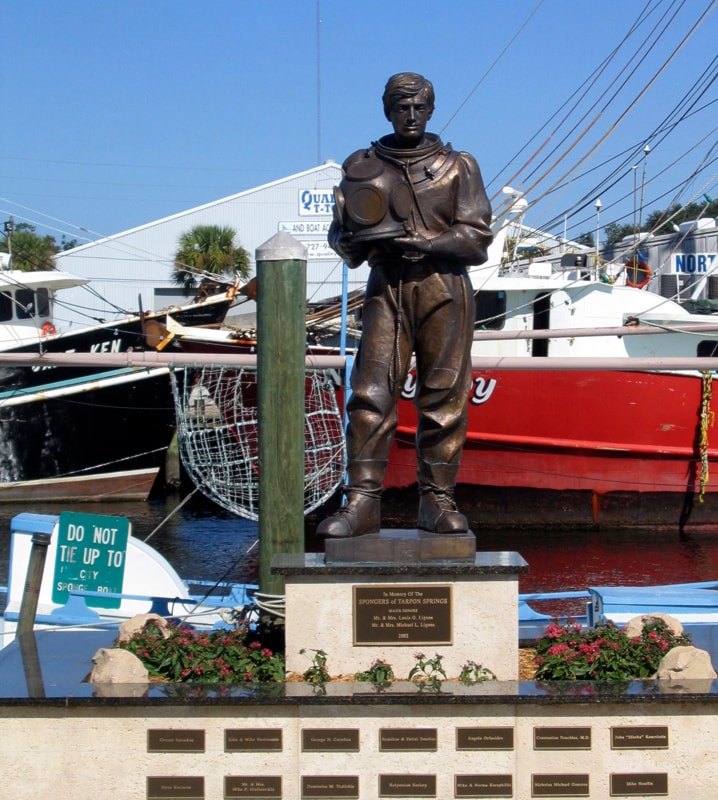TARPON SPRINGS, Fla. — In a spectacle repeated every Jan. 6 for more than a century, dozens of teenage boys set out from the stately Greek Orthodox cathedral in this Florida Gulf Coast town to seek God’s blessing in the chilly waters of a bayou several blocks away.
They dive off row boats and, in a chaotic flailing of arms and legs, grope in the murky water for a wooden cross tossed in by a priest. The one lucky enough to surface with it earns instant celebrity status, a ride through the streets on the shoulders of his peers and — the Greek-American boys believe — the favour of God in the coming year.
The Tarpon Springs “Cross Dive” is the centrepiece of what locals call the largest Epiphany event in the Western Hemisphere, celebrating the day Orthodox Christians believe Jesus was baptized in the River Jordan. Equal parts religious ceremony and community jubilee, it is the signature festival for the waterfront village that draws tourists year-round to its working sponge docks and colourful assortment of Greek restaurants and shops.
Tarpon Springs, 45 minutes northwest of Tampa, boasts one of the largest per capita concentrations of Greek-Americans in the country among its modest population of 22,000. (About 8,000 in town claim such status.) And the Mediterranean influence is everywhere, from the dome of the grand St. Nicholas Greek Orthodox Cathedral downtown to the intricate murals on the walls outside the shops that line Dodecanese Boulevard across the street from the sponge docks.
The city’s population will at least double for the cross dive and Greek festival that follows on Jan. 6. Sixty boys will dive in Spring Bayou this year, with the cross likely thrown by Archbishop Demetrios Trakatellis, leader of the Greek Orthodox Church in America. The boys are 16, 17 and 18 years old, and participation is limited to members of the handful of Greek Orthodox churches in the Tampa Bay area.
“We actually receive requests from all around the country from youths who want to participate,” says Nick Mantzanas, this year’s Epiphany committee chairman, who dove for the cross himself as a teen two decades ago, as did his father before him.
Tarpon Springs, incorporated in 1887, began life as getaway for rich people from the North. Sponges eventually were discovered in the area, and by the 1890s sponge-packing houses were going up on the docks. The sponge business eventually shifted its centre from Key West, Cuba and the Bahamas to Tarpon Springs, and by the turn of the century the city was considered the largest sponge port in the United States.
According to the city’s official history, a man named John Corcoris arrived in Tarpon Springs in 1896 as a sponge buyer from New York. He was hired to make the industry more efficient, introducing the first mechanized sponge fishing boat and bringing in 500 Greek divers from Kalymnos, Halki, Sumi, Hydra, Spetses, Aegina and other Greek islands. More Greek immigrants followed to establish restaurants, candy shops, coffee houses and grocery stores to serve the sponge-fishing community.
Blights of the sponge beds in the 1930s and ’40s, along with the introduction of synthetic sponges, took the oomph out of the industry here, but the community has fiercely maintained its culture and Greek heritage. Tourism is now the area’s leading industry, but professional sponge divers still ply the waters off the coast of Tarpon Springs, as deep as 46 metres, for sponges that are sold in the dockside shops and all over the world via the Internet.
A short walk from the sponge docks is an historic, active downtown popular with tourists and antique hunters. Besides eating and shopping at the sponge docks, visitors can board sight-seeing or charter fishing boats for a few hours out on the Gulf of Mexico.
A unique attraction here is the venerated painting known as “The Weeping Icon of St. Nicholas” in the Greek Orthodox cathedral. Kept under glass in an elaborately carved enclosure, the image inexplicably “wept” at Christmastime for three consecutive years in the early 1970s. The droplets that appeared were never explained, and at the time the Greek Archdiocese in New York termed it a “phenomenon beyond human comprehension.” St. Nicholas is the patron saint of the area’s sponge fishing community, as well as the cathedral.
The business and culture of Tarpon Springs revolves around the Epiphany festival and getting ready for the next one.
“It brings people to Tarpon Springs who might not normally come here or even thought of coming here,” says Sue Thomas, president of the local chamber of commerce. “They see the downtown, they go to the sponge docks. We hear it over and over. We love it.”
If You Go...
TARPON SPRINGS EPIPHANY CELEBRATION: Jan. 6. http://www.epiphanycity.org
TARPON SPRINGS CHAMBER OF COMMERCE: http://tarponspringschamber.com/
GETTING THERE: Tarpon Springs is about 40 kilometres from Tampa International Airport, which is served by most major airlines.
